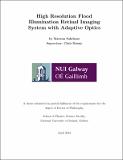| dc.contributor.advisor | Dainty, Chris | |
| dc.contributor.author | Suheimat, Marwan | |
| dc.date.accessioned | 2012-11-08T16:51:38Z | |
| dc.date.available | 2012-11-08T16:51:38Z | |
| dc.date.issued | 2012-07-16 | |
| dc.identifier.uri | http://hdl.handle.net/10379/3048 | |
| dc.description.abstract | Retinal imaging has its advantages both in the research laboratory and medical applications. Acquiring high resolution in-vivo images of the retina requires some form of correction for aberrations. To address that, the field of adaptive optics was adopted from astronomy over a decade ago. High resolution retinal imaging has been achieved using more than one imaging modality coupled with adaptive optics; however, the high cost associated with building those instruments has con fined them to research laboratory until now. Retinal imaging instruments could assist in early diagnosis of certain progressive retinal pathologies, which increases the chances of impeding their progress, and therefore, saving the visual function of some patients. To fully achieve this potential, such instruments must be made accessible to more people.
The aim of this project is to design and build an adaptive optics assisted retinal imaging system that is a ffordable to optometrists. The goal is to image a 4° fi eld-of-view on the retina, with the capability to resolve single cones near the fovea. The approach to cost minimisation was to use commercial o ff-the-shelf optical elements, light emitting diodes to replace current illumination techniques, and a potentially lower cost deformable mirror. Once the preliminary results were acquired, the retinal imaging system was designed and optimised using Zemax. The optimised setup was then built and the control algorithms were written using Labview. The level of detail achieved using the built instrument is discussed in this thesis. This project is a proof-of-concept, and serves as a first step toward building a commercial instrument. This thesis explains the optical design issues and the computer algorithms involved in building the retinal imaging system. We conclude with a few improvement suggestions for the next step in the design process. | en_US |
| dc.rights | Attribution-NonCommercial-NoDerivs 3.0 Ireland | |
| dc.rights.uri | https://creativecommons.org/licenses/by-nc-nd/3.0/ie/ | |
| dc.subject | Adaptive optics | en_US |
| dc.subject | Retinal imaging | en_US |
| dc.subject | Fundus camera | en_US |
| dc.subject | Physics | en_US |
| dc.subject | Science | en_US |
| dc.title | High Resolution Flood Illumination Retinal Imaging System with Adaptive Optics | en_US |
| dc.type | Thesis | en_US |
| dc.contributor.funder | Science Foundation Ireland (07/IN.1/I906) | en_US |
| dc.local.note | The thesis describes the design and build process of an instrument that captures high resolution images of the back of the eye (retina). Those images can help in the early detection and mitigation of certain progressive retinal diseases, such as glaucoma. The instrument is an attempt at cost-minimisation as a starting point for a commercially wide-spread instrument. | en_US |
| dc.local.final | Yes | en_US |
| nui.item.downloads | 849 | |


